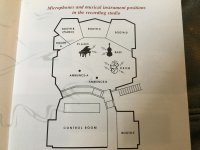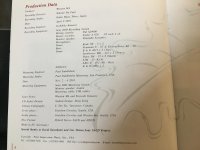The room is another enclosure with it's own resonances. What you are listening to has hopefully been mixed in a room with a degree of damping, but also some reflection, a kind of balance, which is hoped is an approximation of the average listening environment.Lots of reflections in the room, so the room is the cabinet? The room is the enclosure? In which case the usual damping, etc needs to be applied.
Yes, really enjoying lots of music, some new, some old. BTW, Dire Straits is one reputed to have great dynamics, that was not squashed in the studio.
You ask, The room is the cabinet? Sorry I don't follow exactly, if you're referring to the room you are sitting in, or the room inside your monitor-loudspeakers.
It seems that bands that feature a few prominent instruments - guitar, voice, bass, drums of course, seem to have better recordings - lack of space?
Steely Dan is another treat to listen to : Adja now.
I was referring to the room as being as important as the enclosure.
When I started the tread I said:
Never realizing it would lead to stereo experiences. Funnily enough once heard for the first time, I listen for the stereo effect in other settings, in the car, for example, where, unfortunately I cannot sit exactly between the speakers. Will balance compensate?
Now about the recording studio, see this 3D image set here. Where exactly do we want to be, which is the position we want to recreate when we listen? Inside the recording room or in the control room?
recording studio 3d model
I mean I would want to hear the music in my listening space as it is heard by the recording engineer in this picture: this side of the glass.
Recording studio - Wikipedia
What do you prefer?
Aren't we listening to miniatures of music rather than music? How to equalize this so it resembles as far as possible what the live listener hears or recording studio monitors put out?
Never realizing it would lead to stereo experiences. Funnily enough once heard for the first time, I listen for the stereo effect in other settings, in the car, for example, where, unfortunately I cannot sit exactly between the speakers. Will balance compensate?
Now about the recording studio, see this 3D image set here. Where exactly do we want to be, which is the position we want to recreate when we listen? Inside the recording room or in the control room?
recording studio 3d model
I mean I would want to hear the music in my listening space as it is heard by the recording engineer in this picture: this side of the glass.
Recording studio - Wikipedia
What do you prefer?
Balance controls like tone controls are very useful. Notice in that studio there is a lot of room treatment and two sets of speakers for different listening positions
This photo is from the inside cover of a really great recording. Certainly a benchmark or reference recording in my book: Autumn in Seattle - Tsuyoshi Yamamoto. It's on First Impression Music (FIM) label.
It's interesting to me that they chose to put all instruments in the same room,even though individual booths were available in the studio.
I count two mics on piano, two mics on bass, four mics on drum kit, then two mics out in the room to capture ambience.
I'm very curious to know if the piano mics were placed inside the piano cabinet, or if they were just outside the piano. Anyone know?
It's interesting to me that they chose to put all instruments in the same room,even though individual booths were available in the studio.
I count two mics on piano, two mics on bass, four mics on drum kit, then two mics out in the room to capture ambience.
I'm very curious to know if the piano mics were placed inside the piano cabinet, or if they were just outside the piano. Anyone know?
Attachments
So,.. with above diagram, if I were the sound engineer doing the mixing, I would try to balance the tracks from the 10 microphones so that the sound coming out of the speakers in the control room sounded as close as possible to what I would hear if I were siting in a chair between the two ambient mics in the instrument room.
By the way,... please don't think I know what I'm talking about...I'm just guessing and pretending. I've never mixed any music!
By the way,... please don't think I know what I'm talking about...I'm just guessing and pretending. I've never mixed any music!
If your sitting where the ambient mics are you will hear what the mics here, ambiance, which the brain filters out, so it dosnt "sound" that ambient. If you listen to the mics thru head phones you'll think it's way too ambient. I don't remember the exact number but in an average room with an RT60 of a second or so the sound energy ratio of the direct vs reflected sound is 1 at between 10 and 15 feet. Further than that and most of the sound that reaches you is reflected and affected by the room. And after that the direct sound decreases by the inverse square of the distance while the room sound stays the same. So at 100 feet your getting mostly reverb. So the seat your in in a large venue will make a large difference in sound. The amazing DSP in your head balances this out.
My take on live versus recorded. I liken it to video. When you go to a movie would you be ok if the camera sat in one spot ( a long shot to cover the entire stage) and recorded a play and that's what you watched? Why not, it's an exact (as can be) copy of the live show.
As soon as you put up a mic your changing the sound. So why not put them up so it sounds good, not how it sounds 200' away. ( many orchestras are recorded with the main pair over the head of the conductor, this is where I would want to be for a concert, but even then there will be spot mics to adjust the balance.
My take on live versus recorded. I liken it to video. When you go to a movie would you be ok if the camera sat in one spot ( a long shot to cover the entire stage) and recorded a play and that's what you watched? Why not, it's an exact (as can be) copy of the live show.
As soon as you put up a mic your changing the sound. So why not put them up so it sounds good, not how it sounds 200' away. ( many orchestras are recorded with the main pair over the head of the conductor, this is where I would want to be for a concert, but even then there will be spot mics to adjust the balance.
If you want to hear what a piano sounds like to a normal audience then piano mikes need to be outside the piano. If you want something else then the mikes are put wherever this effect is to be found. Ideally, you record in a proper concert space with mikes where the audience would be.
How many concerts have you recorded? Have you ever tried this? Nobody does this. It will sound to roomy.
A typical orchestral recording set up.
Ten Minute Master: Orchestral Recording - MusicTech
Jist: main mics above conductor.
A simpler method, 1 stereo pair.
Classical Orchestra, A-B Stereo
Jist: mics above conductor.
A typical orchestral recording set up.
Ten Minute Master: Orchestral Recording - MusicTech
Jist: main mics above conductor.
A simpler method, 1 stereo pair.
Classical Orchestra, A-B Stereo
Jist: mics above conductor.
Lots of good reading there, but I think I would prefer to hear the best representation of the instruments of the orchestra rather than to recreate the effect of sitting in the audience somewhere.
With rock bands in studios, I would want to hear what the engineer mixed, but also equalize the room, speakers, old cassette tapes etc to try to be more true to the original recording.
With rock bands in studios, I would want to hear what the engineer mixed, but also equalize the room, speakers, old cassette tapes etc to try to be more true to the original recording.
I prefer to hear what the audience would hear, so a stereo mike over the audience is what I would prefer. This is what the BBC used to do, with perhaps a few extras on some instruments; I don't know what they do now.
Apparently the way classical music concerts are recorded is different from recording rock music in a studio. I almost never listen to classical orchestra music, maybe I should try, because I feel I can never have it loud enough to do the recording justice. To quote the music tech link shared before:
Here is a long video about recording studio techniques : at 7:00 he talks about mike placement. And talking of microphones, I have read that there is a preferred set of microphones, but the best microphones are not used because they don't give the accepted sound.
The theories and practices behind orchestral recording contrast sharply to the accepted wisdoms of popular music recording. Mark Cousins has the score.
Here is a long video about recording studio techniques : at 7:00 he talks about mike placement. And talking of microphones, I have read that there is a preferred set of microphones, but the best microphones are not used because they don't give the accepted sound.
Interesting that he uses a mic close up to the bass and electric guitar amplifier speakers, instead of direct. Of course it preserves the sound but at the price of distortion? Maybe that's part of the effect.
In recording pop music or other electronic music there is no sound to preserve, so you just choose whatever miking gives you the effect you want. Only acoustic music has a sound which can be reproduced; when done properly this can be quite convincing. Sadly, few producers actually attempt this.
And some people do try and move recording technology forwards. Beethoven's Diabelli Variations: the Finest Hour of Piano Music in the World | Stereophile.com
I've not listened to many of them, as the usual rule of high fidelity recording applies*, but they are discussed favourably.
*The better the performance generally the worse the recording. Luckily this is less so than it used to be.
I've not listened to many of them, as the usual rule of high fidelity recording applies*, but they are discussed favourably.
*The better the performance generally the worse the recording. Luckily this is less so than it used to be.
Which ones are? I use Deezer quite a bit. I'm thinking maybe you should focus on your speakers a bit more......
Thanks for suggesting Deezer. I am using it now since Yonder discontinued service suddenly.
The stereo effect and a lot of clarity disappeared when I connected my TEA 2025 to the existing speakers. I have now switched back to my 8002A.
Amplifiers matter, amplifier speaker matching matters, and more power is not necessarily better. Looks like a long road ahead.
When I first saw this done I was baffled, but, of course the amp and the speaker are part of the instrument. Good mics can operate with very low distortion at high sound levelsInteresting that he uses a mic close up to the bass and electric guitar amplifier speakers, instead of direct. Of course it preserves the sound but at the price of distortion? Maybe that's part of the effect.
- Home
- General Interest
- Everything Else
- Music Reproduction Systems - what are we trying to achieve?

